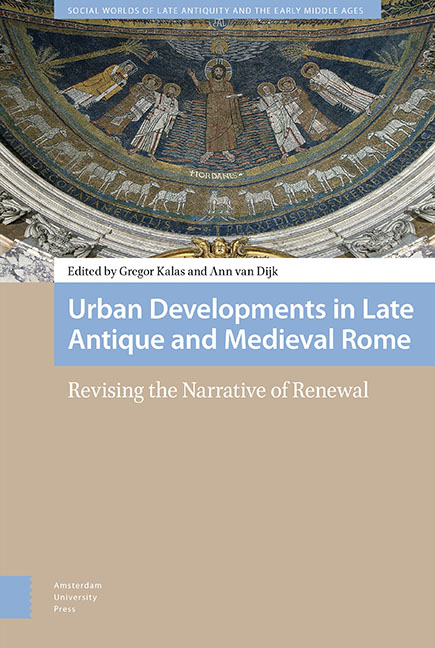Book contents
- Frontmatter
- Contents
- Preface and Acknowledgments
- List of Abbreviations
- 1 Introduction: Revising the Narrative of Renewal for Late Antique and Medieval Rome
- 2 Rome at War: The Effects of Crisis on Church and Community in Late Antiquity
- 3 Portraits of Poets and the Lecture Halls in the Forum of Trajan : Masking Cultural Tensions in Late Antique Rome
- 4 Rolling Out the Red Carpet, Roman-Style : The Arrival at Rome From Constantine to Charlemagne
- 5 (Re-)Founding Christian Rome: The Honorian Project of the Early Seventh Century
- 6 After Antiquity: Renewing the Past or Celebrating the Present? Early Medieval Apse Mosaics in Rome
- 7 The Re-Invention of Rome in the Early Middle Ages
- 8 Rewriting the Renouveau
- 9 Renewal, Heritage, and Exchange in Eleventh-Century Roman Chant Traditions
- 10 Reforming Readers, Reforming Texts: The Making of Discursive Community in Gregorian Rome
- Manuscripts Cited
- Index
7 - The Re-Invention of Rome in the Early Middle Ages
Published online by Cambridge University Press: 18 June 2021
- Frontmatter
- Contents
- Preface and Acknowledgments
- List of Abbreviations
- 1 Introduction: Revising the Narrative of Renewal for Late Antique and Medieval Rome
- 2 Rome at War: The Effects of Crisis on Church and Community in Late Antiquity
- 3 Portraits of Poets and the Lecture Halls in the Forum of Trajan : Masking Cultural Tensions in Late Antique Rome
- 4 Rolling Out the Red Carpet, Roman-Style : The Arrival at Rome From Constantine to Charlemagne
- 5 (Re-)Founding Christian Rome: The Honorian Project of the Early Seventh Century
- 6 After Antiquity: Renewing the Past or Celebrating the Present? Early Medieval Apse Mosaics in Rome
- 7 The Re-Invention of Rome in the Early Middle Ages
- 8 Rewriting the Renouveau
- 9 Renewal, Heritage, and Exchange in Eleventh-Century Roman Chant Traditions
- 10 Reforming Readers, Reforming Texts: The Making of Discursive Community in Gregorian Rome
- Manuscripts Cited
- Index
Summary
Abstract
The history of Rome in the early Middle Ages is best understood as a continuous evolution from Rome of the Caesars to Rome of the popes, with the latter taking on many of the roles of their imperial predecessors. A critical moment occurs in the seventh and early eighth centuries, when the physical ‘landscape’ of the city is ‘re-invented’, essentially transformed from pagan to Christian through an appropriation of the material vestiges of the ancient city, as well as aspects of ritual behavior such as the development of the stational liturgy. This landscape was imbued with memories and meaning, transmitters of the city's identity and history; and these understandings were ‘Christianized’, fulfilling the city's manifest destiny.
Keywords: intramural burial, Old St. Peter’s, Pantheon, papal tombs, litany processions
Few cities can boast that they have served as the capital of an empire extending to three continents, and fewer still can claim that they have played an important role on the world stage for more than two millennia. In fact, there is probably only one: Rome, the ‘Eternal City’ not only in name. Rome’s unique position as a site of continuous and continuing significance is due in part to its geography, and in part to the vicissitudes of its history. But the city's longevity also owes much to its remarkable ability to ‘re-invent’ itself, as appropriate to changing circumstances. And the most significant moment of ‘re-invention’ is also perhaps one of the least studied: the period of the early Middle Ages. No longer the political capital of a far-flung empire, Rome re-invented itself as the urbs sacra, the focal point of a powerful world religion, acquiring a new lease on life that continues to this day.
This process of re-invention did not happen overnight; indeed, it would evolve over many centuries. In the fourth and early fifth centuries CE, as Richard Krautheimer has demonstrated, the physical imprint of Christianity was mostly to be found on the edges of the city, and outside the circuit of the Aurelian walls, focused on the Lateran basilica and the adjacent residence of the bishops of Rome, and the suburban cemeteries with their attached churches and monasteries. The primary patronage of new building activity remained initially lay, not clerical, although gradually extending outwards from the imperial family itself to embrace members of the aristocracy and others with wealth or authority.
- Type
- Chapter
- Information
- Urban Developments in Late Antique and Medieval RomeRevising the Narrative of Renewal, pp. 205 - 236Publisher: Amsterdam University PressPrint publication year: 2021



